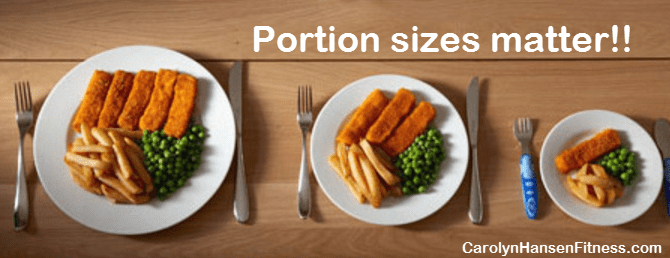 Losing weight is not rocket science. It’s pretty simple actually. It’s really just a matter of energy in versus energy out.
Losing weight is not rocket science. It’s pretty simple actually. It’s really just a matter of energy in versus energy out.
Burn more calories than you consume and you will lose weight.
If we have shifted our diets to healthier food choices but we still seem to be putting on excess weight…or we can’t take off weight we’re trying to lose then “portion sizes” is likely the cause.
Truth is, many portion sizes that appear “average” to you may actually contain a whole day’s worth of calories. For example: a regular order of French fries may not appear that detrimental in size, however the calorie count can be 1,000 or more.
Not only are French fries not the best item for you to be eating if you are trying to lose weight, but the portion size will also work at killing all your weight-loss efforts.
Before starting on any diet plan, it’s wise to have some serving size guidelines in place to avoid serving large portions and over eating.
Here’s a shore guide to help you determine healthy portion sizes for your meals. Following these guidelines, you should be taking in the right level of calories for your gender. Be sure and consider the size of your body when referencing this guide. If you are a larger person or very, very active, you may need to up your servings…especially protein at your main meals. Additionally adding carbohydrates before and after activity will help give you the additional fuel your body requires.
However, for the average individual with average activity and exercise, this chart can be a calories saver…
Here’s some easy tips to help you control your calorie and portion intake:
Divide your meal in two: If you are not starving, why not eat half of what you are served and take the rest home with you to enjoy as another meal. Asking for the box when you are initially served and packaging half of it away immediately will help you to stop at the right time.
Plate size: Our eyes are easily deceived sometimes. When our meals are served on very large plates even if what is served is more than substantial it may appear “less than.” Use smaller plates to make your meals look larger.
Slow down eating and don’t reach for seconds: When you eat too fast, you’ll be reaching for food again before you realize it. Slow down, allow your body to digest and enjoy the food as well as register the fact that it has been fed. Enjoy one serving and walk away.
Cook your meals at home: You’ll be in much better control of what goes into your recipes as well as how much is served at one time if you are cooking your meals at home. Sure, everyone loves to eat out once in a while and that “once in a while” won’t hurt you. But for the most part…rely on yourself and your own kitchen for portion control.
Leave the bags or cartons in the store: Way too easy to overeat when you’re diving into a bag of chips. You can’t see how many are gone and before you know it, you’ve indulged in half a bag.
Share Dessert: There is no reason not to enjoy a bit of sweetness after you’ve eaten a healthy meal…however the calories in desserts…especially those we order out can really set a diet back. The best idea is to order one dessert…or serve just one dessert and share the abundance.
You can also measure portion sizes by using items you are already very familiar with rather than breaking out all the measuring cups and scales.
A single serving consists of:
Fruits and veggies = the size of your fist
Meat, fish or poultry = should be the size of your palms (minus your fingers)
Steamed rice = the size of a cupcake wrapper
Cheese servings = the size of a pair of dice or your whole thumb (from the tips to the base)
Pasta = the size of an ice cream scoop
For more extensive information and to discover a list of 100 foods that are actually good for you as well as a list of those that aren’t, check out: “The Anti-Aging Foods Compendium.” It’s time to discover the difference between low nutrient foods and high nutrient foods and foods that are downright dangerous.

